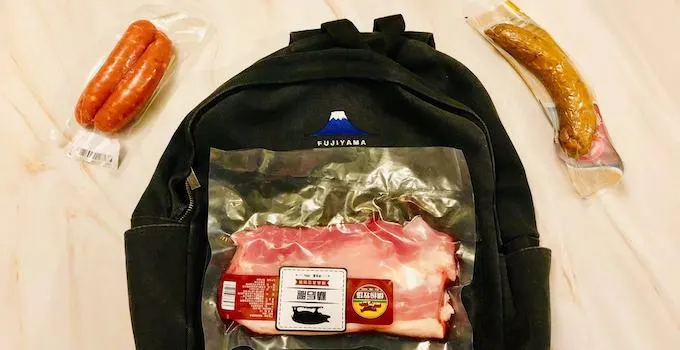Within the EU many goods can easily be carried in hand luggage. It often only becomes dangerous when you travel with your luggage across EU borders.
But is this also the case for meat products? Or are there restrictions and special regulations to be observed? Let’s quickly find out together!
Contents
Are you allowed to transport meat in hand luggage?
For meat, the regulations for the transport of animal products must be observed.
For air travel within the EU, including travel to/from Andorra, Liechtenstein, Norway, San Marino and Switzerland, there are no special restrictions for meat products.
If your journey crosses the borders of the EU, there are strict restrictions/bans on the import/export of meat.
If you enter the EU from a third country (another country other than the EU and the above-mentioned countries that are treated as EU countries in this matter), you are not allowed to import any meat products without a veterinary certificate. Also not for personal use.
Bring meat snacks onto the airplane: allowed?
If you encounter problems with your meat on your flight, this will usually not be the case at the security checkpoint, but much more at customs in the destination country.
Because it is the import regulations of the destination country that are most likely to be your downfall.
For meat snacks on the plane, however, import regulations don’t matter because as long as these meat snacks are intended for the flight and you consume them before arrival (= during the flight), these rules are not to be observed.
Meat snacks for in-flight are therefore no problem, regardless of where the journey takes you.
Recently I was on my way from Beijing to Zurich, where I had a chat with a Chinese lady. She had some meat snacks with her (duck heads in vacuum bags).
When she unpacked them and shared them with her friends, she was told by the flight crew that she was not allowed to bring the snacks to Zurich (not import them).
So she decided to quickly eat all the meat and even offered me the Chinese delicacy. However, I thankfully rejected the well-intentioned gift.
Take sausage on the plane
In principle, the same rules apply to sausages as to meat in general. However, with sausages, the consistency factor also comes into play.
There are no further restrictions on hard sausage.
In the case of spreadable sausages, on the other hand, such as liver sausage and tea sausage, the rule for liquids in hand luggage needs to be observed, as such sausages, which are often used as a spread on bread, are classified as liquids due to their creamy consistency.
By the way, the consistency is also decisive for cheese and often decides whether a dairy product may or may not be carried in hand luggage.
How best to transport meat
If you have the choice between hand or checked baggage, then you should rather store the meat products in checked baggage.
Storage in checked baggage is generally preferable, as the temperatures in the hold are usually much colder than in the cabin. And of course, this is beneficial for the meat.
As far as transport is concerned, the meat is best transported in a vacuum. You can also store the meat in a flat cardboard box, for example.
For longer journeys, transport in cool bags or even in a cool box can be useful. You can stow the cooler bags in checked baggage.
As a rule, a cooler box must be checked in as an additional piece of luggage (depending on whether it is special baggage or bulky goods).
It may also be possible to transport the cooler as hand luggage, but you should double-check this with the airline.
Cooling the cooler/cooling bag/styrofoam (polystyrene) box should preferably be done with dry ice. Dry ice is permitted for most airlines (in limited quantities) both in checked and hand baggage.
As a rule, cold packs are forbidden in hand luggage, as they violate the liquid rule in hand luggage.
Exception for travellers from Greenland, Iceland and the Faroe Islands
If you travel to the EU from Greenland, Iceland or the Faroe Islands, you can benefit from an exemption rule for the import of animal products, including meat and fish, and products made from them.
The quantity you can bring with you is 10 kg (combined total weight per person). You can find further information about this at the Federal Ministry of Food and Agriculture of Germany.
As Germany is a member of the EU, the information that you can find there is obviously also valid for the UK and any other member state of the EU.
What happens if you illegally have meat with you?
If you have meat with you that you are not allowed to take with you, for example when you return to the EU from a third country, it must be destroyed on arrival at the EU border.
Official destruction is at the expense of the importer.
A fine may be imposed on meat products which are (intentionally) not declared.
Why all these meat rules?
The rules are not designed to make it more difficult for passengers to transport meat. The restrictions/bans on importing meat products are designed to prevent animal diseases from being introduced into the EU.
Meat when travelling to/from the USA
Let’s start with the simple part. For travel from the USA to the EU, the rules apply as described above. In plain language, this means: Prohibited. No meat products from the USA can simply be imported into the EU in hand luggage (or other luggage).
When travelling to the USA, the situation is somewhat more complicated. To be honest, much more complicated. It is also true that meat products (fresh, dried or canned) cannot simply be imported into America.
For beef products, however, imports may be permitted under certain circumstances. However, only if the meat comes from a country that is free of BSE (Bovine Spongiform Encephalopathy) and FMD (Foot-and-mouth Disease).
For more information, contact the United States Customs and Border Protection Agency.
Meat in checked baggage
The rules set out in the first section of this Article shall also apply to the transport of meat in hold baggage. That is all there is to say in this context.
Fruit and chocolate in hand luggage
Not only for meat in hand luggage there are special rules to be observed. Even if you carry other food in your (hand) luggage, such as fruit & fruits or chocolate, there are some important things to keep in mind.
Especially when it comes to fruit and fruit, the regulations are not exactly obvious. However, we can help you with that, because we have already written a very detailed post about this exact topic: Fruit in Carry-On Baggage: Respect These Rules!
If you have fruit with you or even want to bring it with you from your holidays, then take a look at this post so that you don’t get into trouble unnecessarily or even have to pay a fine.
If you are travelling with dairy products, be equally careful as there are also strict rules for such products.

Hey guys! It’s me, Marcel. I am the proud owner of carry-on-baggage.com. I am dealing with hand luggage related issues on a daily basis and I own several websites in this niche. Travelling is one of my biggest passions in life and I, therefore, happen to know a thing or two about hand luggage. I hope you all have a safe trip! Take care and thanks for the support. I really appreciate it.
